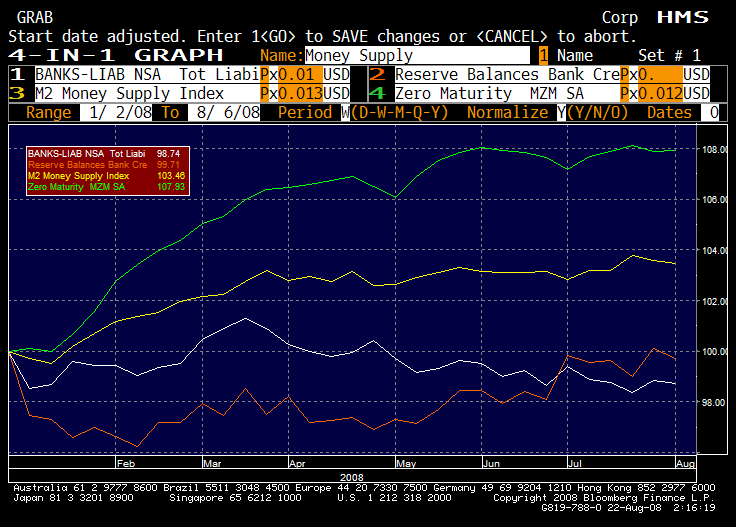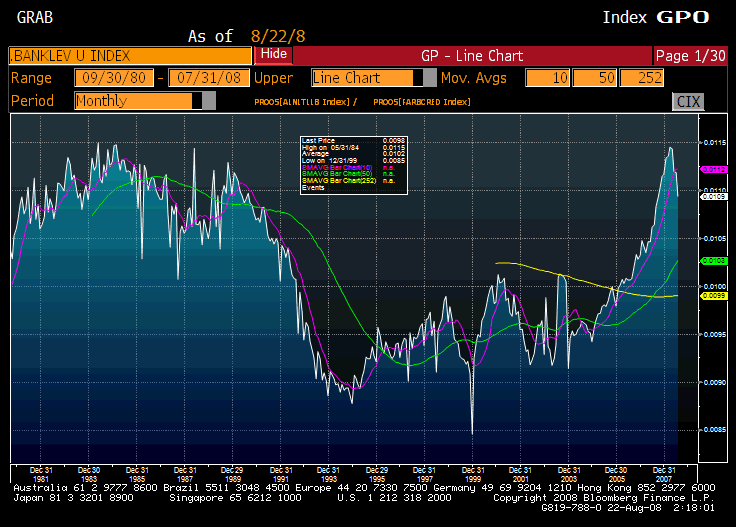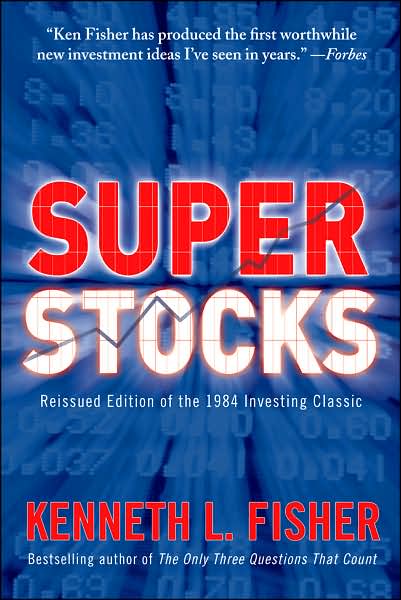This article was posted at The Big Picture this morning as I was guest-blogging for Barry.? That’s a first for me, and there is no better site to do it at.? I present the article here for those that did not see it at The Big Picture.
=–==–==–==–==-=-=–==-=-=-=-=–==-=-=-=-=-=–=-=-=-==-=-=-
This piece completes a series that I started RealMoney, and continued at my blog.? For those with access to RealMoney, I did an article called The Fundamentals of Market Tops, where I concluded in early 2004 that we weren?t at a top yet.? For those without access, Barry Ritholtz put a large portion of it at his blog.? I then wrote another piece at RM applying the framework to residential housing in mid-2005, and I came to a different conclusion: yes, residential real estate [RRE] was near its top.? Recently, I posted a piece a number of readers asked me to write: The Fundamentals of Market Bottoms, where I concluded we weren?t yet at a bottom for the equity markets.
This piece completes the series for now, and asks whether we are at the bottom for RRE prices. If not, when, and how much more pain?
Before I start this piece, I have to deal with the issue of why RRE market tops and bottoms are different.? The signals for a bottom are not automatically the inverse of those for a top. Tops and bottoms for RRE are different primarily because of debt investors.? At market tops, typically credit spreads are tight, but they have been tight for several years, while seemingly cheap leverage builds up.? There is a sense of invincibility for the RRE market, and the financing markets reflect that. Bottoms are more jagged, with debt financing expensive to non-existent.
As a friend of mine once said, ?To make a stock go to zero, it has to have a significant slug of debt.?? The same is true of RRE and that is what differentiates tops from bottoms.? At tops, no one cares about the level of debt or financing terms.? The rare insolvencies that happen then are often due to fraud.? But at bottoms, the only thing that investors care about is the level of debt or financing terms.
Why Do RRE Defaults Happen?
It costs money to sell a home ? around 5-10% of the sales price. In a RRE bear market, those costs fall entirely on the seller. That?s why economic incentives for the owners of RRE decline once their equity on a mark-to-market basis declines below that threshold. They no longer have equity so much as an option on the equity of the home, should they continue to pay on their mortgage and prices rise.
As RRE prices have fallen, a larger percentage of the housing stock has fallen below the 10% equity threshold. Near the peak in October 2005, maybe 5% of all houses were below the threshold. Recently, I estimated that that figure was closer to 12%. It may go as high as 20% by the time we reach bottom.
Defaults occur in RRE when there would be negative equity in a sale, and a negative life event occurs:
- Unemployment
- Death
- Disability
- Disaster
- Divorce
- Large mortgage payment rise from a reset or a recast
The negative life events, which, aside from changes in mortgage payments, can?t be expected, cause the borrower to give up and default. During a RRE bear market, most people in a negative equity on sale position don?t have a lot of extra assets to fall back on, so anything that interrupts the normal flow of income raises the odds of default. So long as there are a large number of homes in a negative equity on sale position, a certain percentage will keep sliding into foreclosure when negative life events hit. For any individual, it is random, but for the US as a whole, a predictable flow of foreclosures occur.
Examining Economic Actors as We near the Bottom
Starting at the bottom of the housing ?food chain,? I?m going to consider how various parties act as we get near the RRE price bottom. At the bottom, typically Federal Reserve policy is loose, and the yield curve is very steep. Financial companies, if they are in good shape, can profit from lending against their inexpensive deposit bases.
This presumes that the remaining banks are in good shape, with adequate capacity to lend. That?s not true at present. Regulation has moved into triage mode, where the regulators divide the institutions into healthy, questionable, and dead. The bottom typically is not reached until the number of questionable institutions starts to shrink. Right now that figure is growing for banks, thrifts, and credit unions.
The Fed?s monetary policy can only stimulate the healthy institutions. Over time, many of the questionable will slow growth, and build up enough free assets to write off bad debts. Those free assets will come through capital raises and modest profitability. Others will fail, and their assets will be taken over by stronger institutions, and losses realized by the FDIC, etc. The FDIC, and other insurance funds, will have their own balancing act, as they will need to raise premiums, but not so much that it harms borderline institutions.
Another tricky issue is the Treasury-Eurodollar [TED] Spread. Near the bottom, there should be significant uncertainty about the banking system, and the willingness of banks to lend to each other. Spreads on corporate and trust preferreds should be relatively high as well. Past the bottom, all of these spreads should be rallying for surviving institutions.
Financing for purchasing a house in a RRE bear market is expensive to nonexistent, but the underwriting is strong. At the bottom, volumes increase as enough buyers have built up sufficient earning power and savings to put a decent amount down, and be able to comfortably finance the balance at the new reduced housing prices, even with relatively high mortgage rates relative to where the government borrows.
Many other players in RRE financing will find themselves stretched, and some will be broken. Consider these players:
1) Home equity lenders will be greatly reduced, and won?t return in size until well after the bottom is passed.
2) Many unregulated and liberally regulated lenders are out of business. The virtue of a strong balance sheet and a deposit franchise speaks for itself.
3) Buyers of subordinated RMBS have been destroyed; same for many leveraged players in ?high quality? paper. Don?t even mention subprime; that game is over, and may even be turning up now as vultures pick through the rubble. This has implications for MBIA, Ambac, and other financial guarantors, since they guaranteed similar business. How big will their losses be?
4) Mortgage insurers are impaired. In earlier RRE bear markets, that meant earnings went negative for a while. In this case, one has failed, and some more might fail as well.
5) Do the GSEs continue to exist in their present form? That question never came up in prior bear markets, but it will have to be answered before the bottom comes. Will the FHLB take losses from their mortgage holdings? Will it be severe enough that it affects their creditworthiness? I doubt it, but anything is possible in this down cycle, and the FHLBs have absorbed a lot of RRE mortgage financing.
6) Securitization gets done limitedly, if at all. This is already true for non-GSE-insured loans; the question is how much Fannie and Freddie will do. My suspicion is near the bottom, as loan volumes increase, banks will be looking for ways to move mortgages off of their balance sheets, and securitization should increase.
7) The losses have to go somewhere, which brings up one more player, the US Government. Through the institutions the US sponsors, and through whatever m?lange of programs the US uses to directly bail out financially broken individuals and institutions, a lot of the pain will get directed back to taxpayers, and, those who lend to the US government in its own currency. It is possible that foreign lenders to the US may rebel at some point, but if the OPEC nations in the Middle East or China haven?t blinked by now, I?m not sure what level of current account deficit would make them change their policy.
That said, the recent housing bill wasn?t that amazing. Look for the US Government to try again after the election.
A Few More Economic Actors to Consider
Now let?s consider the likely actions of parties that are closer to the building and buying of houses.
1) Toward the bottom, or shortly after that, we should see an increase in speculative buying from investors. These will be smarter speculators than the ones buying in 2005; they will not only not rely on capital gains in order to survive, but they require a risk premium. Renting the property will have to generate a very attractive return in order to get to buy the properties.
2) Renters will be doing the same math and will begin buying in volume when they can finance it prudently, and save money over renting.
3) At the bottom, only the best realtors are left. It?s no longer a seemingly ?easy money? profession.
4) At the bottom, only the best builders survive, and typically they trade for 50-125% of their written-down book value. Leverage declines significantly. Land gets written down. JVs get rationalized. Fewer homes get built, so that inventories of unsold homes finally decline.
As for current homeowners, the mortgage resets and recasts have to be past the peak at the bottom, with the end in sight. (In my piece on real estate market tops, I suggested that after the bubble popped ?Short rates would have to rally significantly to bail these borrowers out. We would need the fed funds target at around 2%.? Well, we are there, but I didn?t expect the TED spread to be so high.)
5) Defaults begin burning out, because the number of the number of properties in a negative equity on sale position begins to decline.
6) Places that had the biggest booms have the biggest busts, even if open property is scarce. Remember, a piece of land is not priceless, but is only worth the subjective present value of future services that can be derived from the land to the marginal buyer. When the marginal buyers are nonexistent, and lenders are skittish, prices can fall a long way, even in supply-constrained markets.
For a parallel, consider pricing in the art market. Many pieces of art are priceless, but the market as a whole tends to follow the liquidity of the rich marginal art buyer. When liquidity is scarce, prices tend to fall, though it is often masked by a lack of trading in an illiquid market.
When financing expands dramatically in any sector, there is a tendency for the assets being financed to appreciate in value in the short run. This was true of the Nasdaq in the late ’90s, commercial real estate in the mid-to-late 1980s, lesser-developed-country lending in the late ’70s, etc. Financing injects liquidity, and liquidity creates confidence in the short run, which can become self-reinforcing, until the cash flows can?t support the assets in question, and then the markets become self-reinforcing on the downside, as buying power collapses.
The Bottom Is Coming, But I Wouldn?t Get Too Happy Yet
There are reasons to think that we are at or near the bottom now:
But I don?t think we are there yet, and here is why:
My best guess is that we are two years away from a bottom in RRE prices, and that prices will have to fall around 10-20% from here in order to restore more normal price levels versus rents, incomes, long term price trends, etc. Hey, it could be worse, Fitch is projecting a 25% decline.
Not all of the indicators that I put forth have to appear for there to be a market bottom. A preponderance of them appearing would make me consider the possibility, and that is not the case now.
Some of my indicators are vague and require subjective judgment. But they?re better than nothing, and keep me in the game today. Avoiding the banks, homebuilders, and many related companies has helped my performance over the last three years. I hope that I ? and you ? can do well once the bottom nears. There will be bargains to be had in housing-related and financial stocks.
Full disclosure: no positions in companies mentioned







 When I review books, I don’t just review new books.? I try to share with my readers the books that have helped me become a better thinker on investments.? Fortunately, in this case, the 1984 book Super Stocks was reprinted in 2007.? Perhaps that validates my opinion that this is a valuable book.
When I review books, I don’t just review new books.? I try to share with my readers the books that have helped me become a better thinker on investments.? Fortunately, in this case, the 1984 book Super Stocks was reprinted in 2007.? Perhaps that validates my opinion that this is a valuable book.